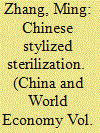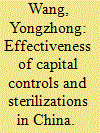| Srl | Item |
| 1 |
ID:
088489


|
|
|
|
|
| Publication |
2009.
|
| Summary/Abstract |
fixed exchange rate arrangement in place from 1998 to 2005. The results obtained from Granger causality tests in a vector autoregression framework indicate that: (i) China actually conducted independent monetary policy during the fixed exchange rate period; and (ii) market-oriented policy measures are impotent in influencing real output and prices. The framework of the investigation into the autonomy of monetary policy adapts to the Chinese economic condition that primary loan and deposit rates are set by the central bank. Based on the empirical results, the present paper provides alternative strategies to improve the effectiveness of monetary policy in China, including developing the financial system and solidifying microeconomic fundamentals instead of forcing the adaptation of a more flexible exchange rate regime.
|
|
|
|
|
|
|
|
|
|
|
|
|
|
|
|
| 2 |
ID:
119205


|
|
|
|
|
| Publication |
2013.
|
| Summary/Abstract |
This paper examines how international capital mobility can be affected by sterilization activities for seven East Asian economies. We develop a model that shows how sterilization measures by a central bank can lead to a reduction in a country's capital mobility. Using data from 1980 to 2006, we then derive sterilization intensities and capital mobility estimates for our countries, and discover that conventional measures overstate the degree of capital mobility due to their failure to adjust for sterilization actions. Our findings are important for policy makers since using our modified estimates will help to better understand the magnitude of capital mobility when central banks exercise sterilization to dampen the effect of capital inflows.
|
|
|
|
|
|
|
|
|
|
|
|
|
|
|
|
| 3 |
ID:
113007


|
|
|
|
|
| Publication |
2012.
|
| Summary/Abstract |
This paper attempts to explain why sterilized intervention was so successful and sustainable in China during the first decade of the 21st century. We argue that the Chinese Government established a sterilization cost-sharing mechanism among the People's Bank of China, commercial banks and the household sector. On the one hand, Chinese commercial banks have to assume some of the sterilization costs by purchasing low yield central bank bills and maintaining high levels of required reserves. On the other hand, Chinese households assume some of the sterilization costs by bearing negative real deposit interest rates. The cost-sharing mechanism under financial repression prevents a huge quasi-fiscal loss by the People's Bank of China as well as high inflation. However, Chinese households have become victims of this financial repression. Faced with the pressure of changing the growth model from investment-driven to domestic consumption-driven, the interest rate will have to be liberalized eventually, which will, in turn, make sterilized intervention unsustainable.
|
|
|
|
|
|
|
|
|
|
|
|
|
|
|
|
| 4 |
ID:
096233


|
|
|
|
|
| Publication |
2010.
|
| Summary/Abstract |
Since 2003, China has been facing a trilemma of determining how to maintain independent monetary policy and limit exchange rate flexibility simultaneously, while facing persistent and substantial international capital flows. The present paper is an empirical evaluation of the effectiveness of China's sterilizations and capital mobility regulations, measured by sterilization and offset coefficients, respectively, using monthly data between mid-1999 and March 2009. We find that the effectiveness of China's sterilizations is almost perfect in terms of the monetary base, but not in terms of M2, and that China's capital controls still work but are not quite effective. Recursive estimation reveals that increasing mobility of capital flows and decreasing effectiveness of sterilizations might undercut China's ability to maintain monetary autonomy and domestic currency stability simultaneously. To solve the trilemma smoothly, China's monetary authority should continue to relax the management of the exchange rate, and take further steps towards deregulation of capital outflows.
|
|
|
|
|
|
|
|
|
|
|
|
|
|
|
|